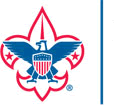Aims and Methods
The Scouting program has three specific objectives, commonly referred to as the “Aims of Scouting.” They are character development, citizenship training, and personal fitness.
The methods by which the aims are achieved are listed below in random order to emphasize the equal importance of each.
IDEALS
The ideals of Boy Scouting are spelled out in the Scout Oath, the Scout Law, the Scout motto, and the Scout slogan. The Boy Scout measures themselves against these ideals and continually tries to improve. The goals are high, and as they reach for them, they has some control over what and who they becomes.
PATROLS
The patrol method gives Boy Scouts an experience in group living and participating citizenship. It places responsibility on young shoulders and teaches youth how to accept it. The patrol method allows Scouts to interact in small groups where members can easily relate to each other. These small groups determine troop activities through elected representatives.
OUTDOOR PROGRAMS
Boy Scouting is designed to take place outdoors. It is in the outdoor setting that Scouts share responsibilities and learn to live with one another. In the outdoors the skills and activities practiced at troop meetings come alive with purpose. Being close to nature helps Boy Scouts gain an appreciation for the beauty of the world around us. The outdoors is the laboratory in which Boy Scouts learn ecology and practice conservation of nature’s resources.
ADVANCEMENT
Boy Scouting provides a series of surmountable obstacles and steps in overcoming them through the advancement method. The Boy Scout plans their advancement and progresses at their own pace as they meet each challenge. The Boy Scout is rewarded for each achievement, which helps them gain self-confidence. The steps in the advancement system help a Boy Scout grow in self-reliance and in the ability to help others.
ASSOCIATIONS With ADULTS
Boys learn a great deal by watching how adults conduct themselves. Scout leaders can be positive role models for the members of the troop. In many cases a Scoutmaster who is willing to listen to youth, encourage them, and take a sincere interest in them can make a profound difference in their lives.
PERSONAL GROWTH
As Boy Scouts plan their activities and progress toward their goals, they experience personal growth. The Good Turn concept is a major part of the personal growth method of Boy Scouting. Scouts grow as they participate in community service projects and do Good Turns for others. Probably no device is as successful in developing a basis for personal growth as the daily Good Turn. The religious emblems program also is a large part of the personal growth method. Frequent personal conferences with their Scoutmaster help each Scout to determine their growth toward Scouting’s aims.
LEADERSHIP DEVELOPMENT
The Boy Scout program encourages youth to learn and practice leadership skills. Every Scout has the opportunity to participate in both shared and total leadership situations. Understanding the concepts of leadership helps a Scout accept the leadership role of others and guides them toward the citizenship aim of Scouting.
UNIFORM
The uniform makes the Boy Scout troop visible as a force for good and creates a positive youth image in the community. Scouting is an action program, and wearing the uniform is an action that shows each Scout’s commitment to the aims and purposes of Scouting. The uniform gives the Boy Scout identity in a worldwide organization of youth who believe in the same ideals. The uniform is practical attire for Scout activities and provides a way for Scouts to wear the badges that show what they have accomplished.


